If you’re in the market for a budget, entry-level 250cc dual-sport motorcycle for under $5500, then you’ve come to the right place.
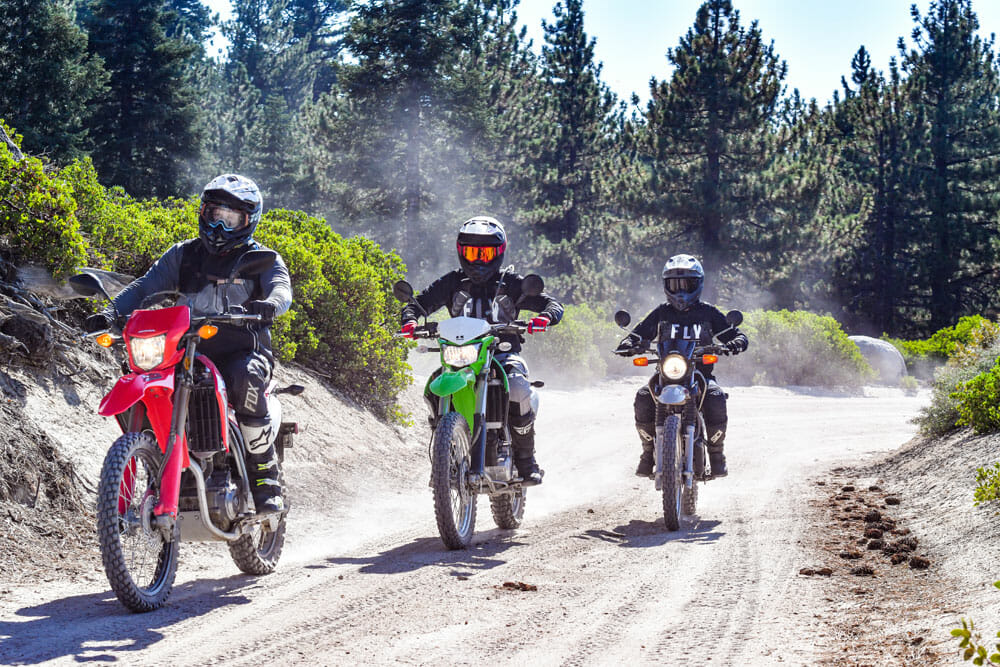
Photography by Kit Palmer
Three motorcycles fit our criteria for this budget-minded entry-level 250cc dual-sport comparison: Yamaha’s often overlooked XT250, Kawasaki’s revitalized KLX250 and Honda’s much-loved CRF250L. We chose this engine displacement because of its versatility and popularity, as it is a good all-around engine size for both experienced and non-experienced riders. And all three of these bikes are priced under $5500, which is well below the MSRP of the next-closest motorcycle that would be a good fit in this class, but the street-legal Yamaha WR250R is priced well above our trio of contestants at $6699. (Don’t worry, we didn’t forget about it entirely in this comparison, nor Kawasaki’s new KLX230.)
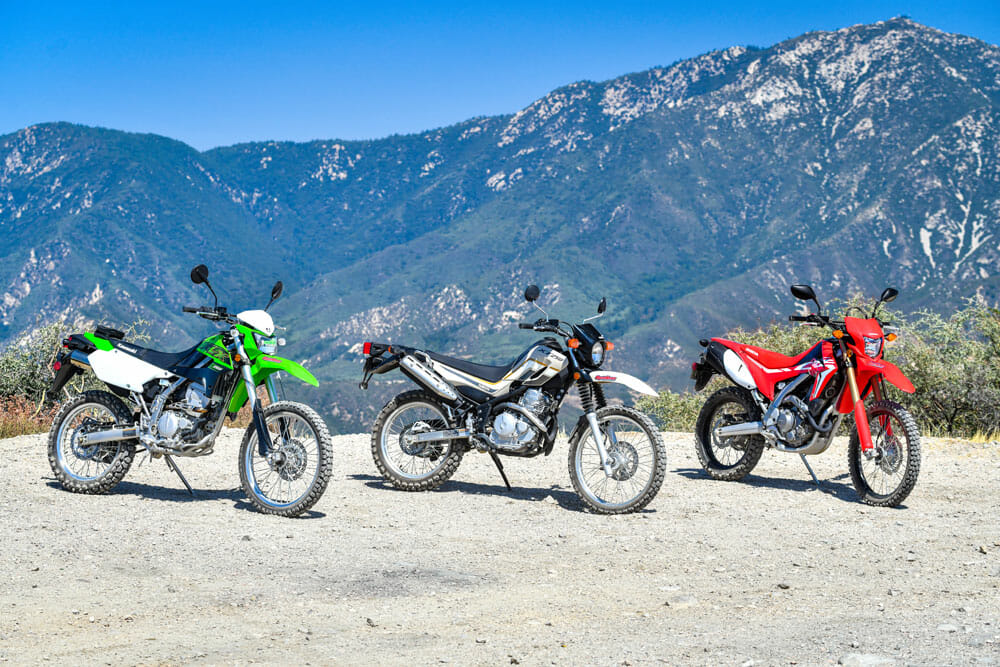
2020 Kawasaki KLX250 vs. Honda CRF250L vs. Yamaha XT250 Comparison
The Contestants
Of the three headliners here, the Kawasaki and the Honda are the most comparable in design. They both have water-cooled DOHC four-valve engines, six-speed transmissions, inverted forks and have similar chassis dimensions in wheelbase, seat height and wheel travel, whereas the Yamaha has an air-cooled SOHC two-valve engine with a five-speed gearbox, conventional forks, a shorter wheelbase, shorter seat height and less wheel travel. Plus, the Honda and Kawasaki have sporty looks, while the Yamaha sticks with a conservative look. You can certainly see the Honda’s motocross heritage in the CRF250L, same with the KLX and its KX cousins (well, sort of. At least the color is the same). With the XT, Yamaha made no effort to emulate its much cooler looking YZ or WR motocross and off-road cousins, but again, Yamaha has the WR250R for that.
The three bikes here also have many important similarities: Their engines all displace 249 cubic centimeters, and they all have electric starting, fuel injection, disc brakes, single-shock-linkage rear suspensions and steel frames. And, as mentioned, their MSRPs are comparable. The Honda and Yamaha share the same MSRP at $5199, though the Honda’s ABS-fitted option (which we tested) checks in at $5499. The Kawasaki has a slightly higher base price of $5399.
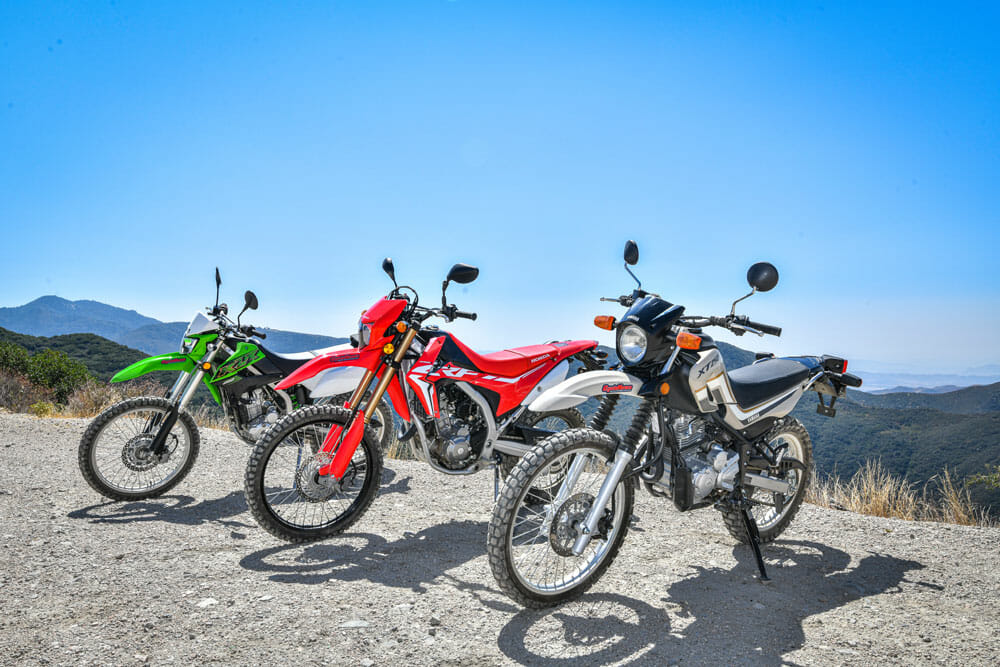
Of the three bikes, the KLX is fitted with the most sophisticated suspension package, which explains its extra $200. The KLX’s suspension provides the most adjustability. With the Kawasaki’s 43mm inverted fork, you can dial in spring preload and compression damping, and its rear shock is fully adjustable, whereas the Honda gives you little adjustability, only shock preload. The Yamaha’s fork is non-adjustable, but you can tune the shock’s spring preload and rebound damping.
Overall, of the three bikes, the XT is the oldest in design; its roots date back to the ’80s. The XT has changed little since its re-birth in 2013 when it got fuel injection and a few other goodies. The Honda got its first and only upgrade in 2017 since its 2012 debut, while the Kawasaki got a significant enhancement in 2018 after a brief hiatus from Kawi’s lineup.
Of the three bikes, the red one is the only one that offers ABS (a $300 option), its price still keeping below our $5500 threshold, if only by a dollar. Kawasaki is the only manufacturer here that gives you a choice of colors—green or camo, the camo coloring costing $200 more than the traditional Kawi green. That puts the camo version over our $5500 budget by $99. Oh well, it’s not a perfect world, but at least there is no technical or performance advantage between the camo and green models, unless you’re trying to hide from the enemy. And besides, we tested the green one, so we’re good. However, Honda gives you a whole other motorcycle option in the $6299 CRF250L Rally, but that’s crossing into an entirely different realm of riding.
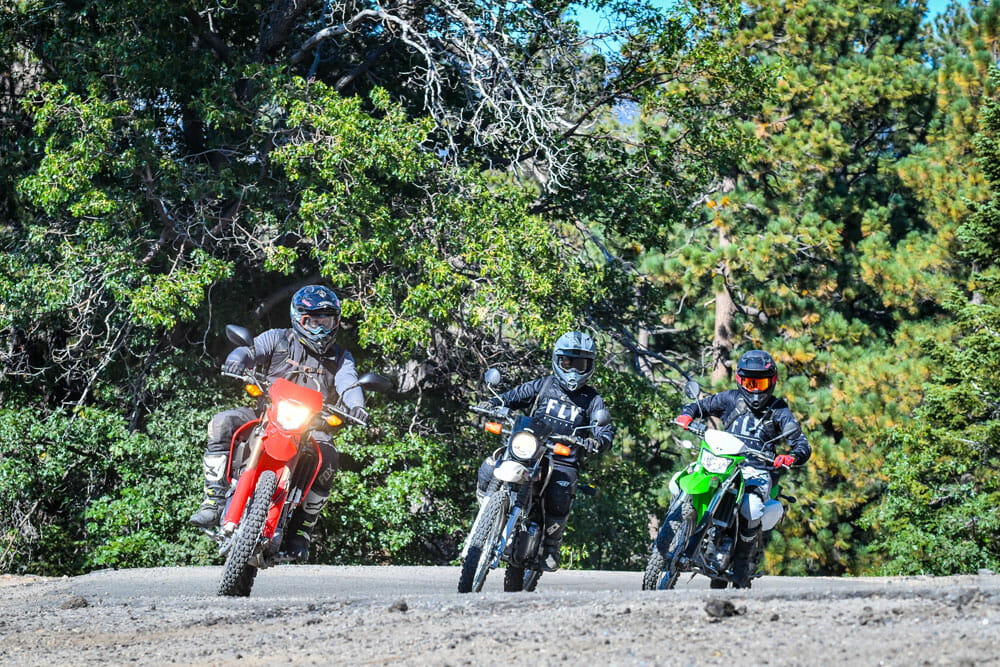
2020 Kawasaki KLX250 vs. Honda CRF250L vs. Yamaha XT250 Comparison
Now, The Fun Part
Most of our testing took place on dirt, where we feel these bikes will be ridden most. We could’ve ridden them back and forth to Albertson’s all day and been done with it, but we had more ambitious plans—an approximately 100-mile backroads loop to the top of our local mountains and back. We traveled from 1350 feet elevation to 7000 feet via roads, of which 90 percent was dirt, of which about five percent was probably more suited for healthy mules.
We’ll get right to the point. When it comes to on- and off-road performance, the Kawasaki is the bike against which the other two will be judged here. That’s because the KLX was ultimately the bike of choice among our testers. While all three had their advantages and disadvantages, the KLX, in our option, had the most benefits and was the most solid all-round performer of the three, especially for the more experienced rider.
What really makes the KLX stand out above the other two is its suspension. It’s just plain better. Period. Compared to the Honda and Yamaha, the KLX’s suspension does a better job soaking up the bumps and doesn’t run out of wheel travel nearly as soon as the Honda or Yamaha.
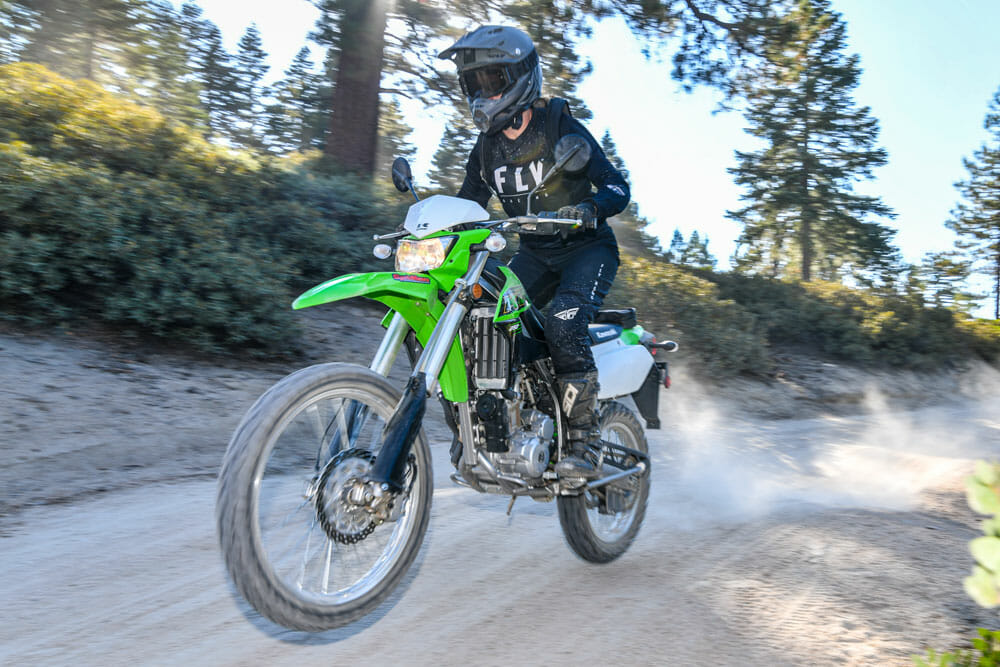
However, we were quite surprised by how good the XT’s suspension actually is, more so than you’d think by just looking at this bike. Despite giving away up to a two of inches of wheel travel to the other two bikes, the XT isn’t afraid of rough roads and tricky trails and handles them quite well, even at speed. Yes, it bottoms easily, but the XT does a great job providing a comfortable, well-balanced ride up until then.
The Honda’s suspension, however, is a little disappointing. It comes from the factory tuned very soft, and there is no easy fix because the shock and forks are non-adjustable, except for rear spring preload. Our real gripe is with the shock. Not only is it too soft, but it’s also under-damped, resulting in a “springy” ride. This becomes more of an issue when the bike is ridden aggressively. Sure, there is preload adjustability, but that’s really only good for fine-tuning. It won’t fix the soft problem even if cranked all the way in. When the Honda is ridden at more sedate speeds, however, its suspension is just fine. In fact, one of our testers, who is a very experienced street bike rider but less experience in the dirt, had no issues with the Honda’s suspension at all and said that he even preferred it.
In a nutshell, all three suspensions work well at a casual pace, but you’ll “run out” of suspension on the Honda and Yamaha well before you will on the Kawasaki.
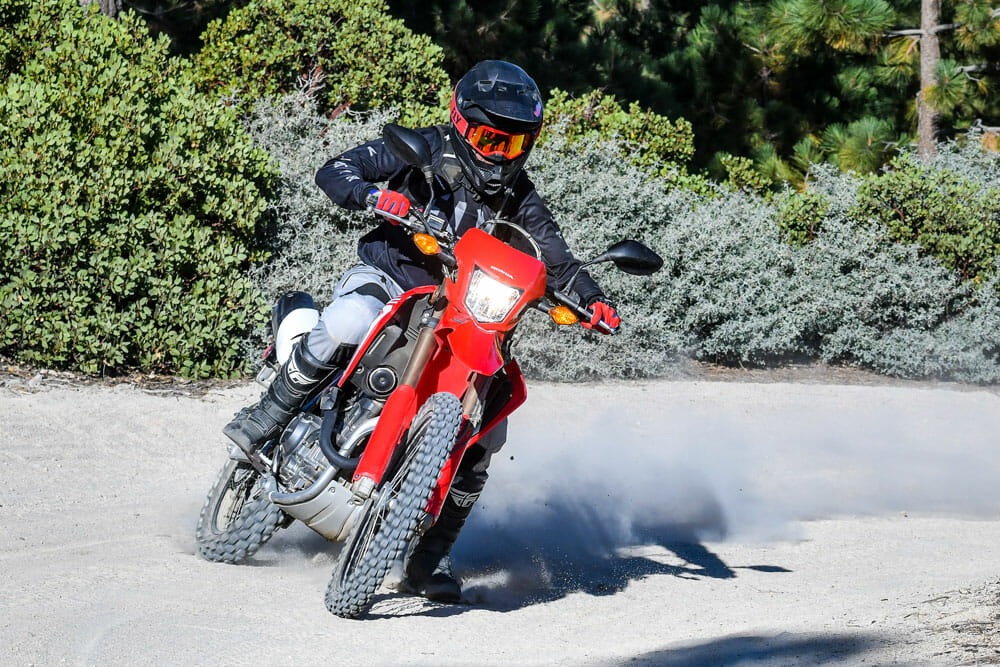
None of the bikes had a significant advantage over the other in the motor department. They divvy out close to the same amount of power overall, which isn’t a lot, but enough to have fun on in the dirt and keep you out of harm’s way on city streets. All three are fun little around-town go-getters and decent commuters, as long freeways aren’t part of the equation. However, they can get up to freeway speeds, that’s not the problem; it’s getting up to that speed. You better find yourself a long onramp.
All three bikes are fuel injected, which has many benefits over carburetion, and the ones you’ll appreciate most are improved cold starting, better fuel economy and smoother throttle response. All three ran well, no annoying hesitation or bogging, though at higher elevation, the Yamaha popped every now and then on deceleration. The Honda wasn’t as quick to adapt to the thinner air. Stopping to not only kill the motor, but turn the ignition off and back on again, seemed to allow it to readjust.
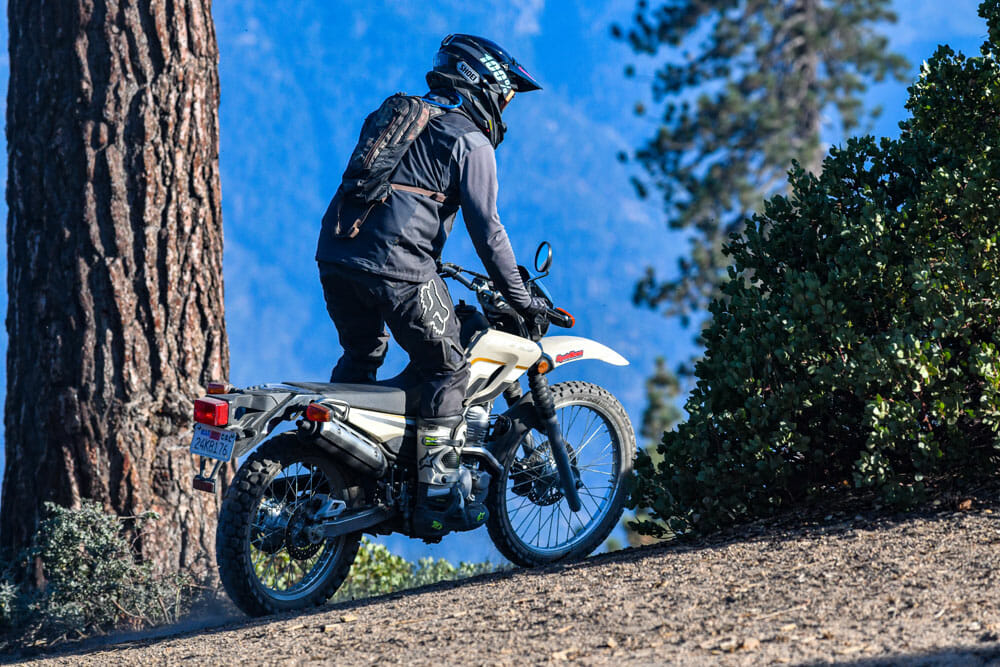
The Kawasaki’s and Yamaha’s transmissions are geared well to their engines, while the Honda’s has a noticeable gap between first and second gears that was annoying on technical trails. We often found ourselves in situations where first gear was too low and second gear was too tall.
Yamaha must have enlisted a small child to design the XT’s shift lever. It’s too short and nearly impossible to wedge a “normal” size foot between it and the footpeg, which was also designed by the same small child.
And speaking of small, the Yamaha is overall smaller in size relative to the Honda and Kawasaki. Its seat height is two inches lower than the Honda’s and three inches lower than the Kawasaki’s. Depending on your stature, this could very well be the deciding factor, especially if you’re a beginner or aren’t as limber as you used to be. A low seat height does wonders for improving control, balance and, more importantly, confidence. Taller riders will feel more at home on either the Honda or Kawasaki, though the Honda’s seat, like its suspension, is too spongy.
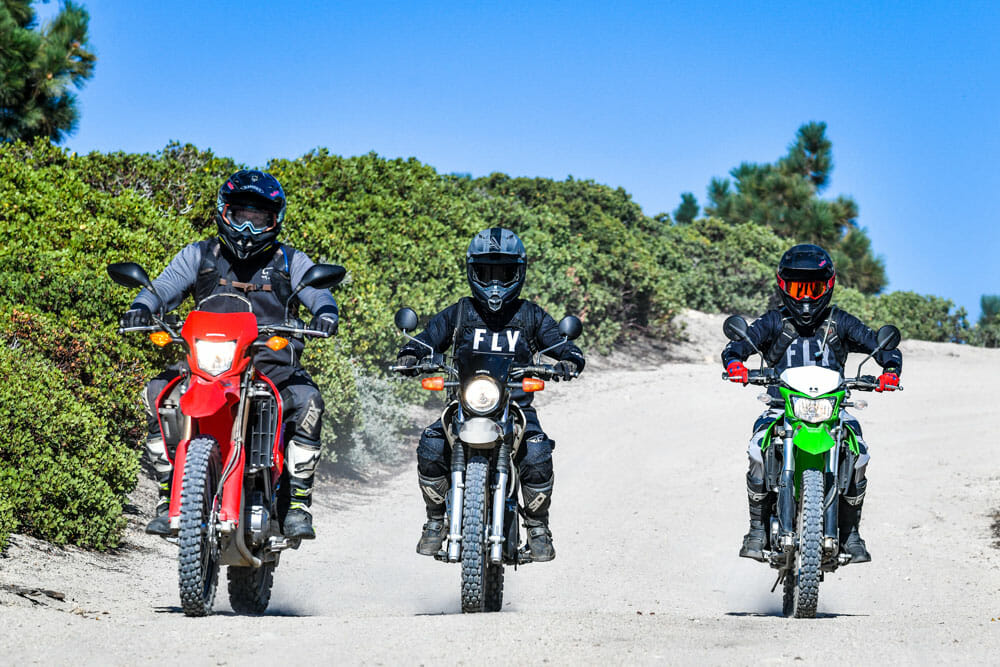
We had no mechanical issues with any of the bikes. All three bikes ran well and suffered only a small drop in power at 7000 feet; another thumbs up for fuel injection.
The Honda has the advantage in the braking department. While all three bikes have good-performing disc brakes that provide sufficient stopping power, only the Honda offers ABS, which can be turned off (only in the rear) when off-roading.
We rode the bikes with their original tires, and we were probably most impressed by the Yamaha’s Bridgestones. Despite having the narrowest profile (front and rear) tires of the three, the XT’s stuck remarkably well to the dirt and gave the rider surprisingly good feedback. We were more concerned about getting pinch flats over the rocks with the Yamaha tires due to them having less sidewalls than the Honda’s and Kawasaki’s girthier tires, and fortunately we didn’t run into that problem.
2020 Kawasaki KLX250 vs. Honda CRF250L vs. Yamaha XT250 Comparison
Around the Campfire
At the end of the day, there are no definitive winners or losers here, only preferences. None of these bikes are designed to get you to the finish line first but, more importantly, just get you to the finish line (back home) with a smile on your face. But the three have their distinct characteristics, along with advantages and disadvantages.
The Yamaha surprised us the most. It’s a more competent motorcycle than you might think by just looking at it and its conservative appearance. It’s a very-good performing motorcycle that does a lot of things well. But it’s the XT smallish size that sets it apart from the Honda and Kawasaki, making it an excellent choice for beginners, or for those with shorter inseams, or for those, as mentioned, who are a bit older and perhaps not as limber as they once were. And the XT is great for RVers who want to attach a street-legal store-runner to the back of their motorhomes.
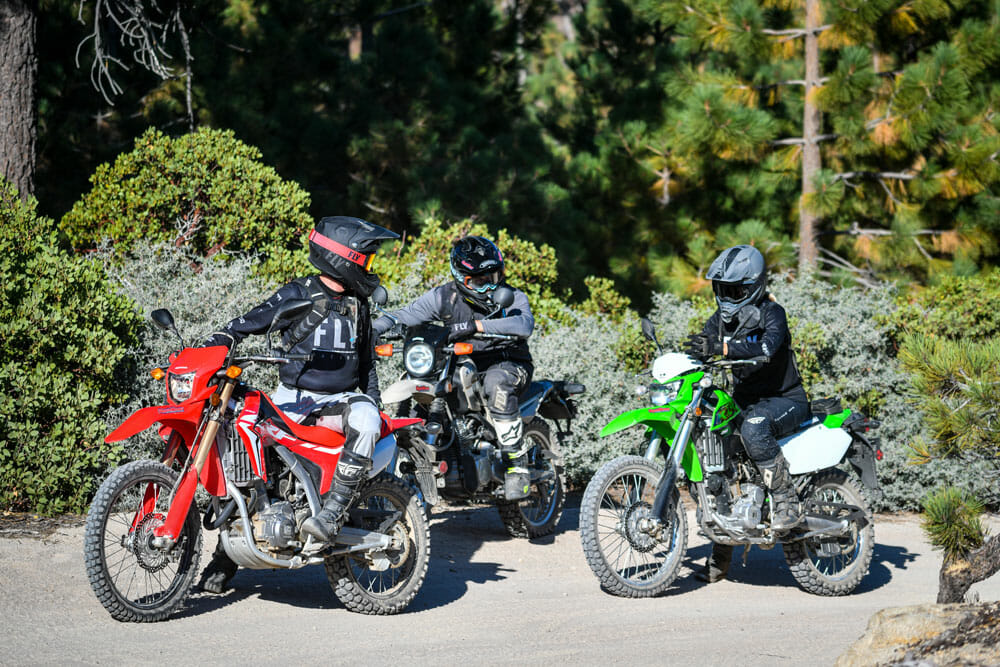
The Honda will appeal to fuller-size newbies who might better appreciate the CRF’s cushy suspension and seat. It’s an easy and unintimidating motorcycle to ride both on- and off-road, and you can get it with ABS. Plus, it looks frickin’ great in the garage. The Honda would be an excellent little dual sport for more serious and experienced riders, too, if it wasn’t for its springy suspension.
The KLX rules the roost here. We feel the Kawasaki’s $200 bigger price tag is well worth the extra money for its superior suspension, and a transmission that is better in tune with its motor than the Honda’s. The Kawi also handles well, has good brakes and is a good looker.
Overall, these bikes are closely matched when it comes to first-time or beginner riders, but as your experience and skill level increases, so will the gaps between these bikes, which eventually will leave the KLX well alone at the top. CN
Sidebar | Kawasaki KLX230
The new Kawasaki KLX230 is also worth mentioning here. Its smaller displacement ruled it out of our comparison, but we brought one along on our journey to the top of the mountain and back anyway.
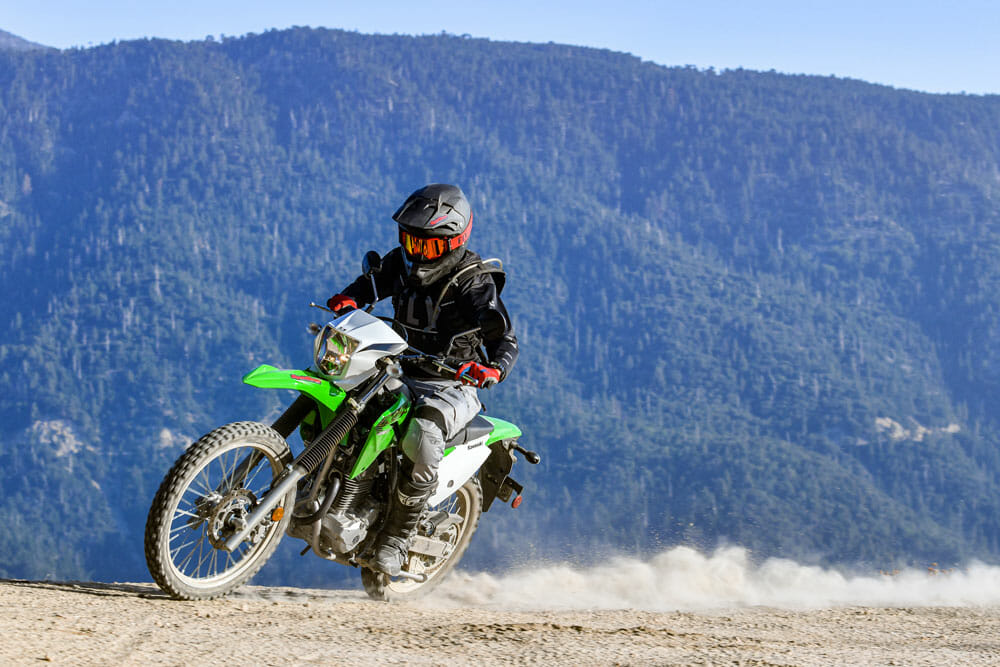
The KLX230 is new to Kawasaki’s dual-sport lineup. Displacement aside, the 233cc Kawi shares many of the same basic engine and chassis designs as the XT, via its electric-start fuel-injected, air-cooled, two-valve SOHC motor, and slightly down-sized frame, smaller profile tires, disc brakes and conventional forks, which are non-adjustable. The shock offers spring preload adjustability. The KLX also has a low 34.8-inch seat height and short 54.3-inch wheelbase. Like the CRF250L, ABS is offered as an option.
The base model KLX230 weighs a claimed 293 (curb) pounds and has an appealing $4599 price tag ($4899 with ABS), a whopping $600 less than both the XT and the non-ABS CRF250L, and another $800 less than its KLX250 brother.
On the trail, the 230 is very impressive. It pumps out 250cc-like power and handles exceptionally well. The suspension is quite good, too, but suffers the same issues as the CRF250L—it’s quite soft and bottoms easily as soon as the pace picks up.
When you’re talking just 230cc here, it’s nice having the six-speed gearbox, which better utilizes every one of those precious cubic-centimeters.
The bottom line? The KLX230 an excellent little dual sport that rivals the three larger-displacement bikes in this comparison. It’s a solid performer with a small price tag. And not only all this, but it’s also a looker!
Sidebar | Yamaha WR250R
The WR250R was way ahead of its time when it made its U.S. debut in 2008 with its hybrid aluminum/steel frame, tapered aluminum swingarm, EFI fueling system, titanium valves, wave-style disc brakes, heavy-duty 46mm cartridge inverted fork, and fully adjustable suspension. However, its hefty price tag reflected this, putting it approximately $1000, at minimum, above its nearest competitors at the time, namely the KLX250S. Even though the WR250R has not changed over the years, its price tag has crept up to its current $6699 MSRP. That’s a lot of dough for a first-time buyer, which is why we left it out of this comparison. However, the WR250R does merit a mention.
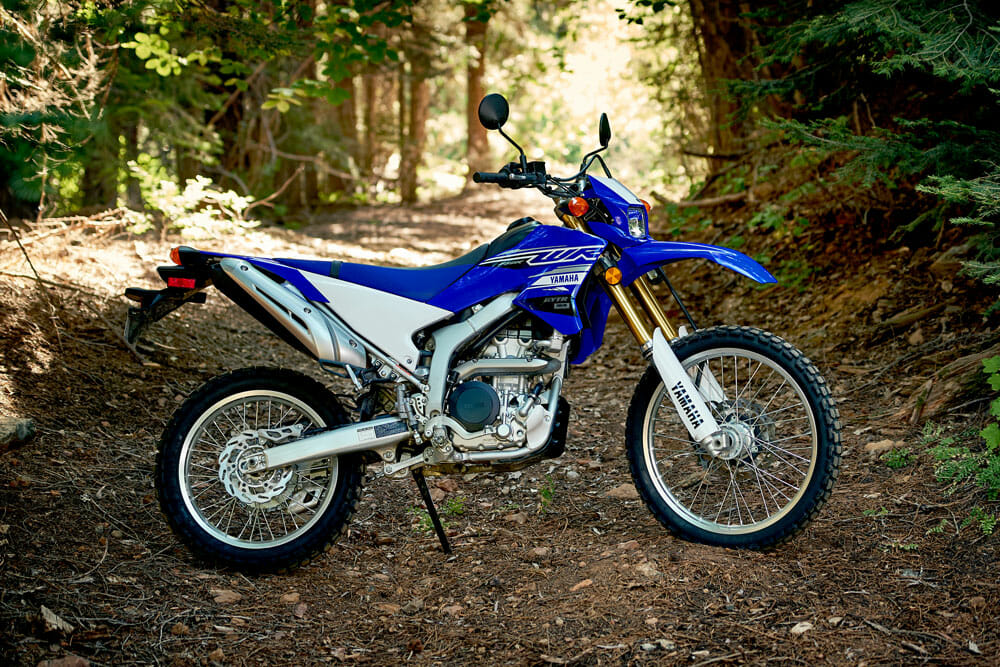
Two years ago, we compared the WR250R with the KLX250 and CRF250L. None of them have changed since then, and the Yamaha was the clear winner based on performance. It was, and still is, a much more capable motorcycle of the three when ridden aggressively over rough terrain. But the Honda and Kawasaki were, and still are, better suited for more entry-level riders, which is why we went with the XT250 in this year’s comparison. (You can read our 2018 250cc dual-sport shootout here.)
The WR250R excels when it comes to handling and suspension. Its high-tech KYB fork, SOQI shock, and long wheel travel will keep the aggressive rider quite pleased, as will the Yamaha’s strong brakes. A big strike against the Yamaha when it comes to first-time riders is its tall 36.6-inch seat height. The WR, however, doesn’t have a huge advantage when it comes to power over the other bikes, even the XT250, but the WR is still the bike for more hard-core dual-sporters shopping in the quarter-liter category.
2020 Yamaha XT250 Specifications
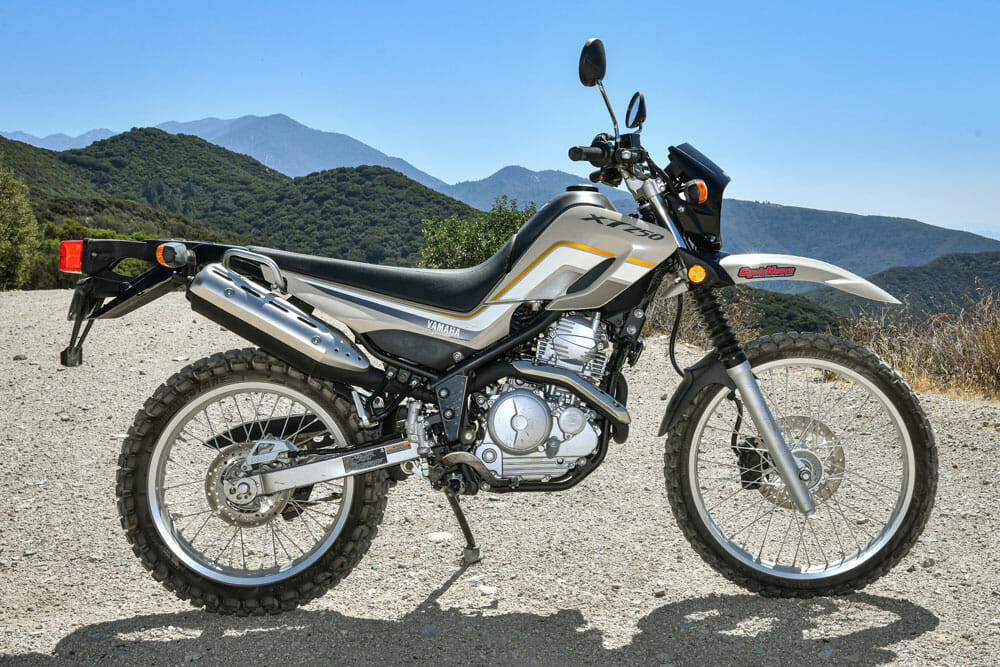
| MSRP: | $5,199 |
| Engine: | 4-stroke, single |
| Displacement: | 249cc |
| Cooling: | Air |
| Valvetrain: | SOHC, 2-valve |
| Bore x Stroke: | 74.0 x 58.0mm |
| Compression Ratio: | 9.5:1 |
| Fuel Delivery: | Fuel injection |
| Starting System: | Electric |
| Ignition: | TCI: Transistor controlled ignition |
| Transmission: | 5-speed |
| Front Suspension: | 35mm telescopic fork, non-adjustable |
| Rear Suspension: | Single shock, preload/rebound damping adj. |
| Front-Wheel Travel: | 8.9 in. |
| Rear-Wheel Travel: | 7.1 in. |
| Front Brake: | Single 245mm disc, 2-piston caliper |
| Rear Brake: | Single 203mm disc, 1-piston caliper |
| Front Tire: | 2.75-21 in. Bridgestone Trail Wing TW-301 |
| Rear Tire: | 120/80-18 in. Bridgestone Trail Wing TW-302 |
| Seat Height: | 31.9 in. |
| Wheelbase: | 53.5 in. |
| Rake: | 26.4° |
| Trail: | 4.2 in. |
| Ground Clearance: | 11.2 in. |
| Fuel Capacity: | 2.6 gal. |
| Fuel Economy (claimed): | 76 mpg |
| Weight (wet, claimed): | 291 lbs. |
Honda CRF250L Specifications

| MSRP: | $5199/$5499 ABS |
| Engine: | 4-stroke, single |
| Displacement: | 249.6cc |
| Cooling: | Liquid |
| Valvetrain: | DOHC, 4-valve |
| Bore x Stroke: | 76 x 55mm |
| Compression Ratio: | 10.7:1 |
| Fuel Delivery: | Fuel injection |
| Starting System: | Electric |
| Ignition: | Digital transistorized |
| Transmission: | 6-speed |
| Front Suspension: | 43mm telescopic fork, non-adjustable |
| Rear Suspension: | Single shock, pre-load adj. |
| Front-Wheel Travel: | 9.8 in. |
| Rear-Wheel Travel: | 9.4 in. |
| Front Brake: | Single 256mm disc, 2-piston caliper, ABS |
| Rear Brake: | Single 220mm disc, 1-piston caliper, ABS |
| Front Tire: | 3.00-21 in. IRC Trails GP-21 |
| Rear Tire: | 120/80-18 in. IRC Trails GP-22 |
| Seat Height: | 34.4 in. |
| Wheelbase: | 56.9 in. |
| Rake: | 27°60′ |
| Trail: | 4.4 in. |
| Ground Clearance: | 10.0 in. |
| Fuel Capacity: | 2.1 gal. |
| Fuel Economy (claimed): | 76 mpg |
| Weight (wet, claimed): | 321.0 lbs. |
Kawasaki KLX250 Specifications
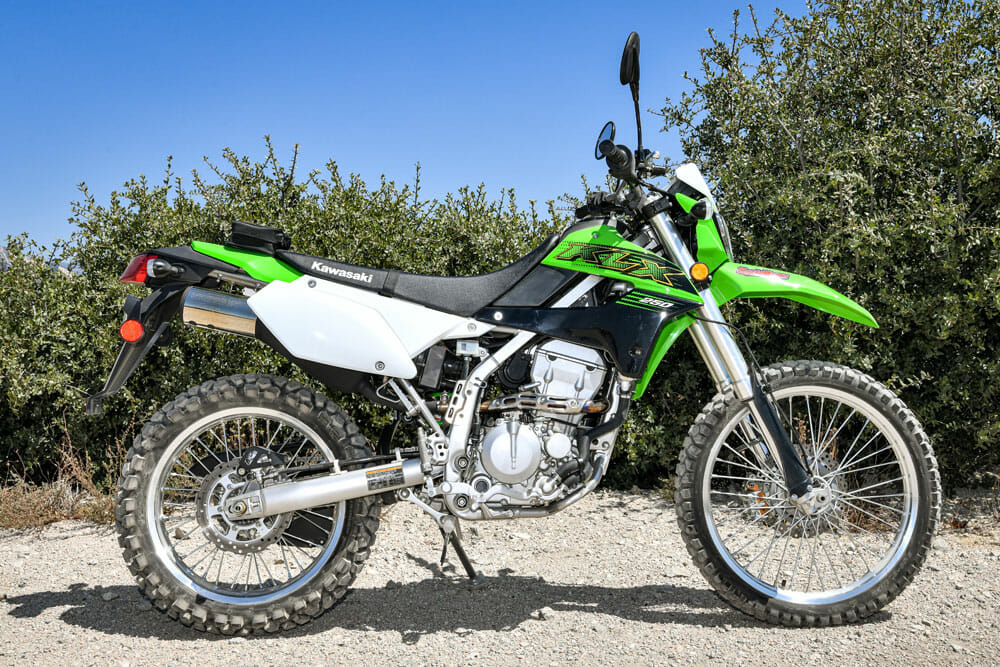
| MSRP: | $5,399 |
| Engine: | 4-stroke, single |
| Displacement: | 249cc |
| Cooling: | Liquid |
| Valvetrain: | DOHC, 4-valve |
| Bore x Stroke: | 72.0 x 61.2mm |
| Compression Ratio: | 11.0:1 |
| Fuel Delivery: | Fuel injection |
| Starting System: | Electric |
| Ignition: | Electric CDI |
| Transmission: | 6-speed |
| Front Suspension: | 43mm telescopic fork, preload, compression damping adj. |
| Rear Suspension: | Single shock, fully adjustable |
| Front-Wheel Travel: | 10.0 in. |
| Rear-Wheel Travel: | 9.1 in. |
| Front Brake: | Single 250mm disc, 2-piston caliper |
| Rear Brake: | Single 240mm disc, 1-piston caliper |
| Front Tire: | 3.00-21 in. Dunlop D605 |
| Rear Tire: | 4.60-18 in. Dunlop D605 |
| Seat Height: | 35.0 in. |
| Wheelbase: | 56.3 in. |
| Rake: | 26.5° |
| Trail: | 4.1 in. |
| Ground Clearance: | 11.2 in. |
| Fuel Capacity: | 2.0 gal. |
| Fuel Economy: | N/A |
| Weight (wet, claimed): | 304.3 lbs. |
Click here for the latest Cycle News Dual Sport motorcycle reviews and news.
Click here for more Honda motorcycle reviews and news.
Click here for more Kawasaki motorcycle reviews and news.
Click here for more Yamaha motorcycle reviews and news.
September 23, 2020 at 09:00PM
https://ift.tt/3hWTIgD
2020 Kawasaki KLX250 vs. Honda CRF250L vs. Yamaha XT250 Comparison - Cycle News
https://ift.tt/38hkzRl
Honda

No comments:
Post a Comment